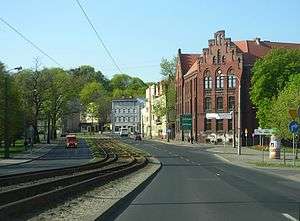Bernardyńska Street in Bydgoszcz
| Bydgoszcz | |
|---|---|
| <span class="nickname" ">Polish: Ulica Bernardyńska w Bydgoszczy | |
|
View of the street | |
|
Location of Bernardyńska Street in Bydgoszcz | |
| Former name(s) | Kaiserstraße, Julian Marchlewski street |
| Part of | Bydgoszcz Old town district |
| Namesake | Cistercian cloister |
| Owner | City of Bydgoszcz |
| Length | 450 m (1,480 ft) |
| Location | Bydgoszcz |
| Construction | |
| Construction start | 1855 |
| Inauguration | 1872 |
| Wikimedia Commons has media related to Bernardyńska Street in Bydgoszcz. |
Bernardyńska street is an historic axis of Bydgoszcz Old Town.
Location
Bernardyńska street delimitates the eastern edge of the Bydgoszcz Old Town. It extends along a north-south axis, from Jagiellonian roundabout to Bernardyński roundabout, via Bernardyński bridge on the Brda river. Its length is approx. 450 m.
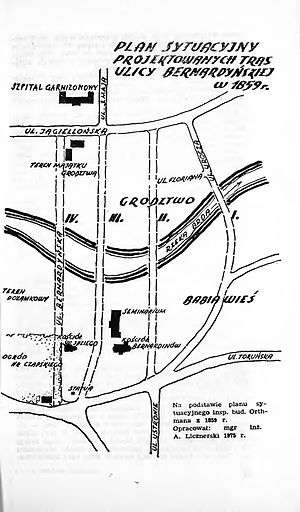
Naming
The street bore the following names:[1]
- 1870 - 1920, Kaiserstraße
- 1920 - 1939, Bernardynska Street
- 1939 - 1945, Kaiserstraße
- 1945 - 1949, Bernardynska Street
- 1950 - 1956, Julian Marchlewski street
- From 1956 - Bernardyńska Street
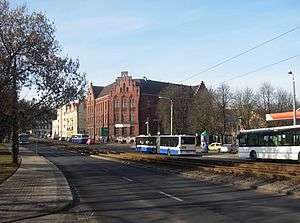
Bernardynska Street gets its name from the Bernardine Monastery inhabited by monks from 1480 to 1829: today still stands the Church of Our Lady Queen of Peace in Bernardyńska Street.
The German name refers to Wilhelm I, German emperor and king of Prussia.
History
Bernardynska Street was born from a mid-19th century project to extend the road connecting the Old Town to the suburbs. In addition, the construction of the a Prussian Eastern Railway line passing through Bydgoszcz in 1851 and the building of the Main station in the north-west of the city emphasized the need of a new bridge over the Brda River, so as to abate the traffic in Mostowa street and its narrow bridge. The eastern location was selected because of the need to reach the newly created suburbs in the 1830s.
On December 7, 1855, an official application was filled for the construction of the new in the area of the former Bernardine monastery.[2] Many official and financial difficulties, associated with the definition of the course of the street and acquisitions of terrain made the project drag on, coming to completion only 20 years later (1875):[2] discussions with landlords and neighborhood about path locations went on till 1863!
Another problem has been to cover the cost of "Most Bernardyński", the bridge over the Brda river, which was a key element of the route: Prussian authorities conditioned the approval of the project upon the realization of a single-span bridge structure, leaving the navigation on the river open and safe. The issue has been solved only in 1866, with a promise from the Prussian government to fund the bridge.[2]
The construction work for the bridge started in 1867, first steel elements set on May 15, 1870, and the final completion of the Bernardyńska street occurred in 1872.[2] The new axis was named "Emperor street", (German) Kaiserstraße), in honor of William I, at that time newly proclaimed Emperor of the German Empire.
Architecture
Main places and buildings
Tenement at N°1A
20th century
-
Main view from the street
-
Detail of the entrance
Tenement at N°3
1893-1905, by Karl Bergner[3]
-
Main frontage
-
Detail of the gate
Bernardine Church of Our Lady Queen of Peace

Kuyavian-Pomeranian Heritage list N°601227, Reg.A/674 (March 4, 1931) and N°601228, Reg.A/674 (September 30, 1992).[4]
Mid-16th century
Polish Gothic architecture, Renaissance architecture
History
The origin of the church dates back to the arrival in 1480 of Bernardine monks in Bydgoszcz, coming from Krakow. The decision to invite Bernadines has been made by king Casimir IV Jagiellon while staying in Bydgoszcz castle during the Thirteen Years' War (1454–66) against the Teutonic Knights.[5] On December 5, 1480, Wloclawek's bishop Zbigniew Oleśnicki granted the erection in Bydgoszcz of a Bernadine monastery, the third one in Poland after Krakow's and Warsaw's. Official founders were King Casimir IV Jagiellon, Hińcza from Rogów, Jarand from Pomian, Bydgoszcz's starost Jan Kościelecki and Bydgoszcz city council. Extract from a Bernardine monastery chronicle:[6]
" On the other side of the Brda River, to Kujawy settled down our brothers. A place was given to them with the consent of His Majesty the Polish King Casimir IV Jagiello, His Most Reverend Zbigniew Oleśnicki, bishop of Wloclawek. His episcopal Majesty arrived together with his brother Michał Bal and his brother Stanislaw from Kłobuck, yore a famous of preacher, and two other brothers, designated by order of His Majesty to choose the place according to their taste. Attending also were its highness Jan Kościelecki, governor of Bydgoszcz, (...) There, the brothers chose a place convenient to the monastery as they saw it. "
The construction of "St. Jerome and St. Francis church" has been completed in 1485 and the monastery library in 1488. The original temple was made of brick, as depicted by notes of a preserved chronicle of Bernardine:[7] "Brothers of the Order after receiving permission for the construction of the convent, performed bricks, prepared lime, (...) cleared the bushes".
Like often, the Bernardine monastery created an outstanding environment for intellectual culture development in Bydgoszcz. In the years 1518-1524, the abbey was led by Bartholomew of Bydgoszcz, a scholar, author of the first Latin-Polish dictionary (1532, 1544). During the XVIIth century, the abbot, Paweł of Łęczyca, was an active supporter of urban decorations, founder of the extensive gardens of the monastery, which were ancestors of today's Bydgoszcz parks. The Bernardines created the largest library in the city (1919 volumes, partially preserved until today at the municipal library) and established a rhetoric school (1529-1774), an observatory (1677), and a brewery. On August 10, 1545, a lightning stroke the abbey, causing a fire that burned down the church and a large part of the monastic buildings, the only buildings left were the library along with the vestry and the infirmary.
On September 23, 1552, king Sigismund II Augustus granted permission for the reconstruction of the burned Bernardine church, with a caveat to its height that should not be taller than the neighboring castle for military-defensive purposes. Its architecture reflects Gothic and Renaissance characteristics. "Saint George church" was built from 1552-1557, thanks to the financial support of the Kościelecki family. Temple name was then changed to "Holy Trinity".[8]
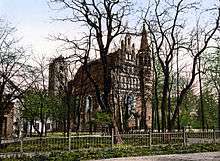
On September 10, 1559, Sebastian of Żydowo, a suffragan of Gniezno, consecrated the Holy Cross altar in the church, and in 1563, Gdańsk bell-founder Herman Benincke cast the great bell of the monastery. The completion of the reconstruction lasted till the years 1590-1602: at that time, city nobleman Stanislaw Małżewski unveiled the altar of the Holy Cross in the newly built Saint Anne chapel on the south side of the church (the chapel is still standing today). In 1595, Dorothy of Spławski, Jan Kościelecki's wife, the Starost of Bydgoszcz, decorated the chapel of the convent with polychrome and three green rugs. The same year has been also erected the Saint Anne Brotherhood altar. Damaged during Swedish wars, the building has been rebuilt and renovated in the second half of the XVIIth century:
- the western church peak was made taller (1648-1686),
- the church tower was rebuilt with a square body (1677), as it is today,
- in 1682-1685, to commemorate the 1683 Battle of Vienna, a chapel was built in the courtyard in front of the church, modeled after the sanctuary in Loreto.
Under Prussian rule, in the church were reported seven altars, with a rich decor and a collection of liturgical objects. According to a site survey carried out in 1745, the church was covered with tiles, the sanctuary having a ceramic floor with aisles made of wood.[6]
In 1605, in the choir, was set a pipe organ, founded by Andrzej Grudziński and Daniel Jastrzębski, town citizens. It was enlarged in 1618, then completely renovated in 1715. It survived until the Secularization of the church decided by Prussian authorities.
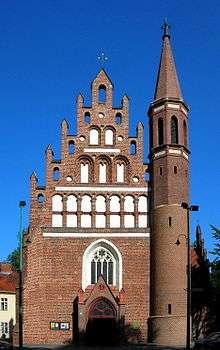
Until the end of the XVIIIth century, the crypt was used to bury religious members of the Bernardine Monastery, along with regular people who deserved to be honored by the convent and the church. Most important figures are buried under the floor of the church, including, among others:[9]
- Paweł Koszucki (1609), secretary of the king and Poznan Wojski, lord of the royal village of Bartodzieje near Bydgoszcz,
- Mikołaj Jastrzębski (1610), disciple of Bernardine observance,
- Kazimierz Dornowski (1695), nobleman,
- Katarzyna Raczyńska (1695), wife of a judge from Naklo,
- Katarzyna Orzelska (1703), noblewoman,
- Stanisław Piniński (1715), burgrave of Bydgoszcz,
- Michał Komierowski (1766), nobleman,
- Teresa Grabowska (1769), royal favorite.
The main church suffered damages in 1812, during the stay of Russian troops. In 1817, with the secularization decided by Prussian authorities, the expropriation of the Bernadine religious property happened, but only at the death of the last monk of the congregation, father Nagabczyński in 1829. The abbey have then provided sanctuary for the Evangelical community (1830) and for evangelical seminary teachers. The cloister and the arcades connecting the church to the monastery were destroyed at this time. In 1840-1860, buildings were turned into a warehouse for furniture, straw or cartridges (the same happened to the Poor Clares' Church on Gdańska Street). In 1838, the church has been dedicated to the garrison's use, for Catholic and Evangelical soldiers ((German) Simultankirche). Later the Prussians destroyed the "Loreto chapel", and deeply rebuilt the interior of the church.
From 1864-1866, the church was completely restored, under the supervision of Ferdinand von Quast, with Prussian funds. The main effort was the reconstruction of the western gable church with Gothic Revival features: this gave this circular tower with its porch and the neo-Gothic peak, as we can notice today on the main elevation.
After 1920, Polish authorities confirmed the use of the church for garrison purposes, and it is still used as such today. The church has been re-consecrated in 1923, by military bishop Stanisław Gall. In 1926, it was renamed "Saint George military parish church". During World War II, the building has been administered by the German War Ministry and after 1945, it served again as Polish army garrison church. In 1952, a rector has been nominated for the church, re-consecrated to Saint George on May 31, 1971.
Architecture
The church was built according to late gothic style. The oriented building without transept has got plastered blind openings, friezes and bands panes. From the north to the chancel stands a square church tower - with a XVIIth century bell tower. The top of the main facade is crenelated, with neo-gothic pinnacles built in 1864-1866. The south-west corner of the church has a cylindrical tower, topped with a brick spire. Nave windows incorporate neo-Gothic traceries.
Inside, the nave church is built with groin vaults. The walls are covered with XVIIth century tombstones. Adjacent to the church stand:
- the old remining buildings of the Bernardine Monastery,
- the Chapel of Saint Anne built at the end of the XVIth century.
In the church is the oldest fresco heraldic of the city: an eagle from the first half of the XVIIth century.
In 1967, archaeological excavations in the south of the church revealed foundations of the "Loreto chapel", remnants of cloister galleries and a former municipal water oak pipe from the XVIth century. In 1999, were discovered underground crypt burials. The oldest object is a rococo pulpit from the 2nd half of the XVIIIth century.
Other furniture have moved to the cathedral in the 1850s, such as:
- Saint Roch altar (1696) - in the southern nave, right of main entrance gate,
- Saint Anthony altar (beginning of XVIIIth century) - in the southern aisle, left of main entrance gate.
-
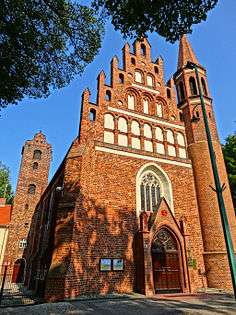
Main elevation with church tower in the backdrop
-
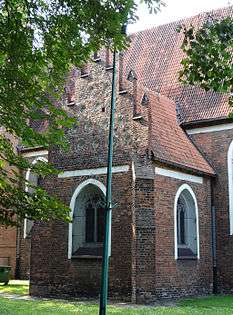
Side chapel
-
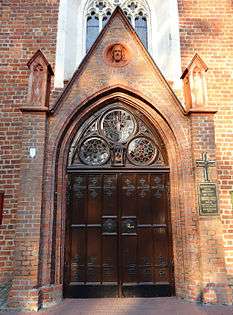
Main portal
-
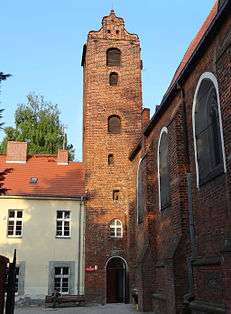
Church main tower
-

Remnants buildings of the Bernadine complex
-
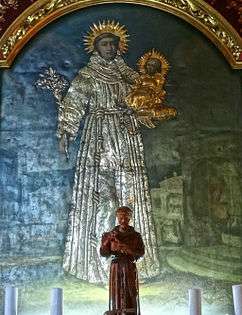
Saint Anthony altar, now in Bydgoszcz cathedral
-
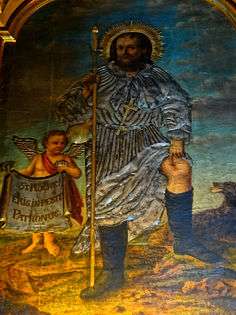
Saint Roch altar, now in Bydgoszcz cathedral
Building at N°6
Kuyavian-Pomeranian Heritage list N°601266, Reg.A/675 (September 30, 1992).[4]
1867-1872
Historicism, elements of Neo-Gothic and Neo-Romanesque
History

The building was erected in the late 1860s for the Evangelical Seminary Teachers, linked to a medium-sized state school in Bydgoszcz.[1] The seminar has been created on May 1, 1820, one of three centers of this type in Grand Duchy of Posen.[10] The facility trained teachers for urban and rural elementary schools. From 1822, the Prussian Ministry began to part from the evangelical education institutions, where youth of all faiths were attending. In Bydgoszcz, it was decided that the seminary would educate evangelical teachers, while in Poznan the same institution was converted into a school for catholic teachers. In Bydgoszcz, a separate Catholic seminary would be created later on.[11] The seminary took quickly the character of a German Protestant philosophy institution from 1825. Nearby, the ancient Bernardine monastery housed in 1830 a Lutheran community. In the years 1867-1872, while partly rebuilding the monastery, an evangelical seminary was also constructed in the vicinity. At that time, it was a three-year curriculum. Seminary was financed from state resources. Courses, apart from general and pedagogical subjects, also considered singing, music instruments, as well as horticulture and handicraft.[12] Between 1870 and 1872, the new Bernadyńska street was built on the western side of the building, and in 1880, on the front square was unveiled a War Memorial to commemorate the officers and soldiers who died on the fronts of military campaigns conducted by Kingdom of Prussia (Second Schleswig War in 1864, Austro-Prussian War in 1866 and Franco-Prussian War in 1870-1871). The monument has been liquidated in 1922, at the same place has been standing since 1925 the "Monument of the Unknown Insurgent of the Greater Poland Uprising".[13]
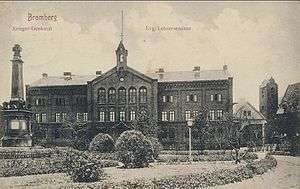
After 1920, when Bydgoszcz was part anew of Poland, the massive outflow of Germans from the city let the Protestant seminary for teachers useless. The building then housed in 1923 the "University of Agriculture" coming from Poznan.[14] It was a 2.5 year long school which accepted applicants over the age of 17, having completed the sixth class of high school and one year of general practice in the farm. The curriculum changed to three years for boys, as a State Secondary School of Agriculture. In 1927, 86 students were enlisted, of which 46 coming from rural area. In 1935, the institution was transformed into a "State High School Farm", the first in the country, culminating with the matura examination, which grants the access to university.[14] The school building provided excellent housing conditions. On the back of the property was a large vegetable and fruit garden, in addition the school had its own 90 ha farm in the vicinity of Bydgoszcz.[14]
During Nazi occupation, the building housed the German Labour Office. After the end of World War II,the Polish Labour Office has been standing there, then a Technical Equipment department. In the late 1960s, the edifice has accommodated a branch of the University of Life Sciences in Poznań, focusing on agriculture (and animal husbandry from 1972). In 1971, with the return of the Agricultural College to Poznan, the institution became an independent branch of the university of Bydgoszcz as a Faculty of Agriculture (Division of zootechnics).[15] Department headquarters were located in the building at Bernardyńska street 6, with other facilities in Hetmańska and Mazowiecki streets as weel as in Osielsko. At that time, it employed 80 teachers. In 1974, after the merger of the College of Engineering with Bydgoszcz Faculty of Agriculture, the building housed the seat of the Department of Agriculture of Bydgoszcz university. In 1975, this department was the first at the university to be granted the right to confer doctoral degrees in agricultural sciences.[15] In 1991, some departments were transferred to the new university facility in Fordon and to a building on Kordecki street. From 2006, the edifice houses a Department of Agriculture and Biotechnology from the University of Technology and Life Sciences of Bydgoszcz.
Architecture
The building displays characteristics from Historicism, with elements of Neo-Gothic and Neo-Romanesque. Its footprint is rectangle-like, with a basement and two storeys. the front avant-corps is topped by a triangular, with a tower which used to house a bell. Front upper floor in the avant-corps has got arched windows. Brick facades are divided by narrow pilasters and decorated with arcade cornices.[16]
-

View of the back from Brda river
-

Front elevation from Bernardyńska Street
-
Front avant-corps
-
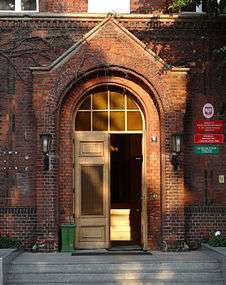
Main gate
-
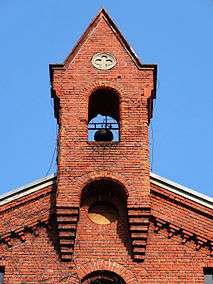
Top of the facade
Bernardyński Bridge
1872
Construction of the bridge was planned to relieve the bridge of the old town, linking the old marketplace ((Polish) Stary Rynek) to the Theatre square. Works started in 1867,[17] with the necessity to realize a one-span bridge that does not hinder water navigation on the river. The roadway had a width of 7.32, with a pedestrian way, based on cantilever beams.[18] The steel bridge had two arched lattice girders, it was lit by four gas lamps standing on each side. The building was complete in 1872 under the name Kaiserbrücke,[19] referring to William I, emperor of Germany and king of Prussia.
At the beginning of XXth century, part of the renovation of the Wisła-Oder waterway required to rebuild the bridge to meet the constrains of modern shipping: it was necessary to raise the structure above the water by 60 cm. The new bridge thus was re-opened in 1903 and has stood till the outbreak of World War II. It has been blown up on September 4, 1939, by Polish sappers from the 62nd Infantry Regiment in order to prevent German forces from crossing the Brda. Provisionally rebuilt by Germans in autumn 1939, it has been again destroyed by the retreating Nazis on January 22, 1945.
After World War II, remains of the bridge have been extracted from the Brda river and scrapped. From 1945 to 1960,a temporary wooden crossing has been set up, at the same location as today's bridge.[20]
The structure's rebuilding began in 1960, and was completed in 1963. The bridge has been built by overhangs, for the first time in the country by means of movable scaffolding. The designer, Maximilian Wolff received for it the second prize from the Committee for Construction, Urban Planning and Architecture.[20] Bridge has re-opened in December 1963: it had a middle-track line for tramway, dual carriageway road with two lanes each and sidewalks for pedestrians. Partial repair occurred in 1968, a full overhaul in 2000. Since 2005, the structure is illuminated by night.
-

View of Bernardyński bridge in 1910
-
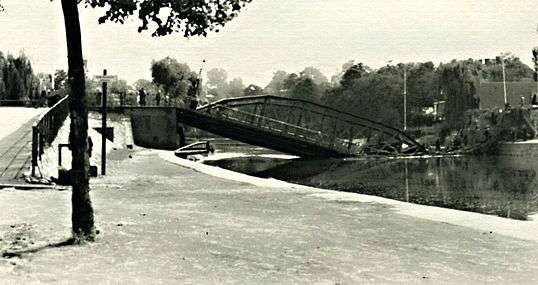
Bernardynski bridge destroyed in 1940
-

Bird eye view
-
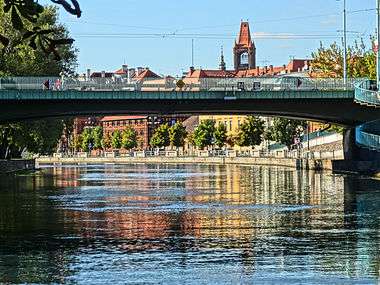
View from the Brda river
-

Night illuminations
Old Building of Bydgoszcz Rowing Association
Kuyavian-Pomeranian Heritage list N°601291, Reg.A/1091 (January 18, 1994).[4]
Corner of Bernardyńska Street and St. Florian street
1914, by Theodore Patzwald
The building has been erected by the architect Theodore Patzwald for the German Rowing Club "Frithjof" established in 1894.[21] The club joined from 1923 to 1945 the "Frithjof Rowing Club", a German rowing association. After World War II, the edifice has housed the Bydgoszcz Rowing Association, or BTW ((Polish) Bydgoskie Towarzystwo Wioślarskie),[22] born on March 16, 1920, under the name "Tryton Rowing Association" (Polish: Towarzystwo Wioślarzy Tryton Bydgoszcz).[23] In 1996, the building has been sold by municipal authorities of Bydgoszcz to a company, "Shanghai Olym-Poland", which set up a hotel and a catering center for Chinese people traveling in Poland and around Europe. In 2010, the building became a hotel and gastronomic restautant "Zatoka" ("The Gulf").[24]
-
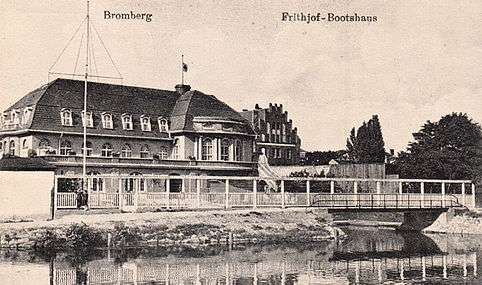
Building of German Rowing Club "Frithjof" 1917
-
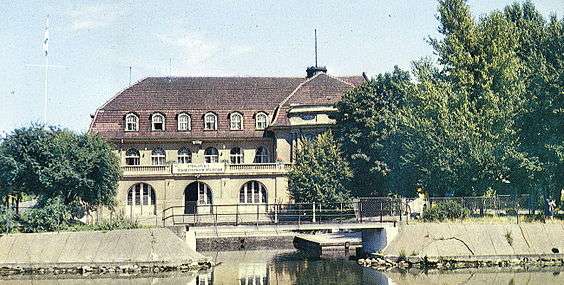
Building of Rowing association "BTW" 1973
-
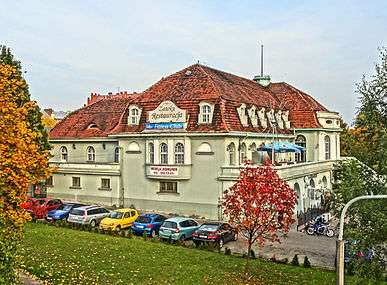
View from Bernardyński Bridge
Building at Plac Kościeleckich N°8
Kuyavian-Pomeranian Heritage list N°601370, Reg.A/888 (June 21, 1993).[4]
Corner of Bernardyńska Street and Kościeleckich square
1890
The building was constructed from 1890 to 1892, on a design by architect Carl Meyer.[25] By 1920, it served as the first school for girls ((German) Erste Mädchen von Volkschule). In 1921, the building housed a Polish primary school "K. Piramowicz". It was a 7-class, primary school, for which headmaster in 1925 was Father Smarzyk, and in 1933 Father Menzel. By 1930, it functioned together with the German, evangelical primary school, located in a wing of the building. In 1933 were created two schools of mixed (girls and boys) pupils.[26]
During German occupation, the edifice accommodated for some time a prison, then in 1945 a military hospital. After World War II, it housed primary school No. 8 "Tadeusz Kosciuszko". With the closure of primary school N°8 in 2004, and after considering to lodge there city's appeal court, it has been eventually decided to put a Secondary School of Organization and Management. Since 2007, the building also houses the Museum of Freedom and Solidarity in Bydgoszcz.
In 2010, the building has been transferred to the ownership of Bydgoszcz's University "Casimir the Great".[27]
The building's architecture is characteristic of XIXth century's public buildings in Bydgoszcz, with references to in the neo-gothic and Neo-Romanesque.[28] Carl Meyer, the designer also realised several other edifices in downtown Bydgoszcz, among others:
- House at Gdanska Street 60;
- House at August Cieszkowski Street N°6
- Bydgoszcz Water supply station, along with architect Marshall.
The building has a brick façade. It is based "L" shape with wings, two-storey, a basement and an attic. The elevation is divided by pilasters and adorned with brick-made friezes running under the cornice. Avant-corps are topped with crenelated triangular gable.
-
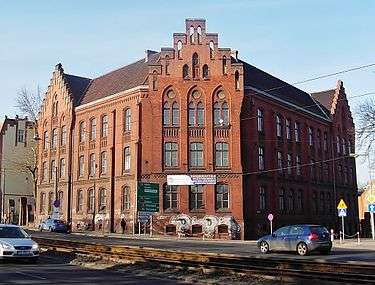
View from Bernardyńska Street
-
Wing on Kościeleckich square
-

Detail of an avant-corps
-
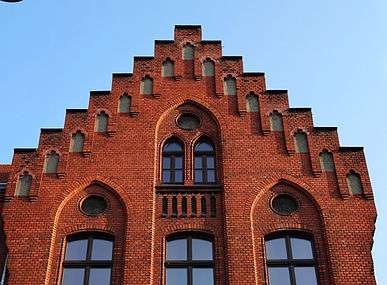
Detail of the crenelated gable
Holiday Inn Hotel
Grodzka St.36-Bernardyńska Street
2010
This 4-star hotel of 138 rooms has been built in 2010 at the eastern tip of Grodzka street.
-

Facade onto Grodzka Street
-
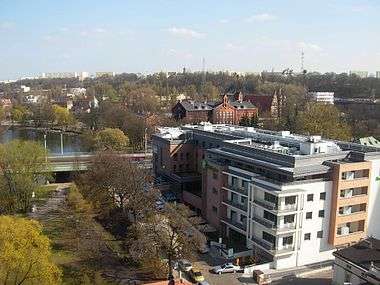
Bird eye view
-
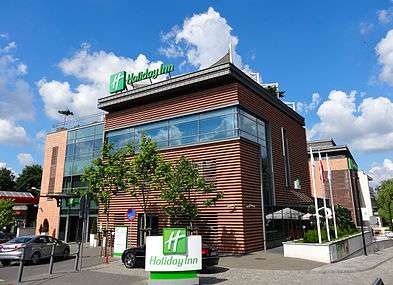
View from Bernardyńska street
Building at N°13
Bernardyńska Street 13
1964
This office building has been constructed by company Projprzem SA, on a design by project architect Witold Jańczak on the corner of Bernardyńska and Stary Port Street, along the Brda river. It has been thoroughly modernized in 2004. Company Projprzem SA, established in 1948 as an engineering office, has become in 1990 a joint stock company, listed on Warsaw Stock Exchange.[29]
-
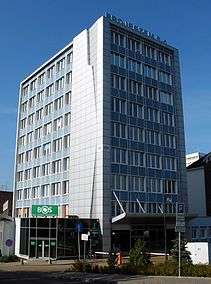
Building view from Bernardyńska street
-
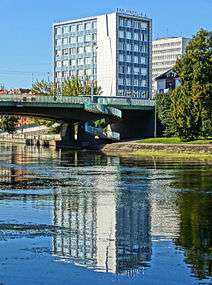
The building with Bernardyński bridge on the foreground
-
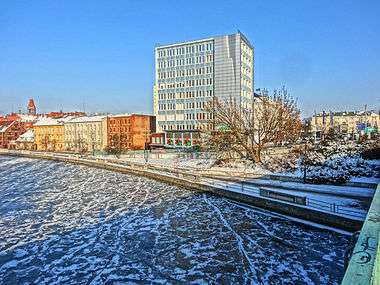
View from Bernardyński bridge
Building at N°15
Bernardyńska Street 15
1955
The building of the "Computation Centre of Polish Post Office" has been built in the years 1955-1957, and thoroughly modernized between 1994 and 1995. At its birth in 1920, this institution in Bydgoszcz was the "Audit Office of Polish Post", covering a range of activities throughout the country. In 1935, its name has been changed to "Accounting Chamber of Control of Post and Telecommunications" ((Polish)Izba Kontroli Rachunkowej Poczty i Telekomunikacji), and 1951 to "Central Bureau of Posts and Telegraphs Settlements" ((Polish) Centralne Biuro Rozrachunkowe Poczt i Telegrafów). Since Polish Post restructuring in 1991, the building in Bydgoszcz houses an organizational unit of the company.[30]
-
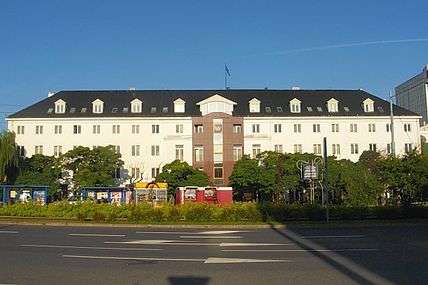
View of main elevation from Bernardyńska Street
-
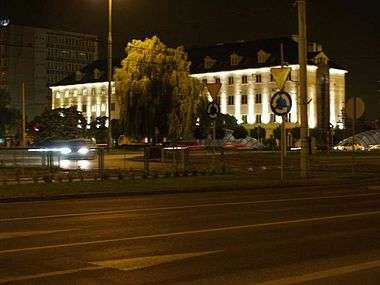
By night from Bernardinska roundabout
-
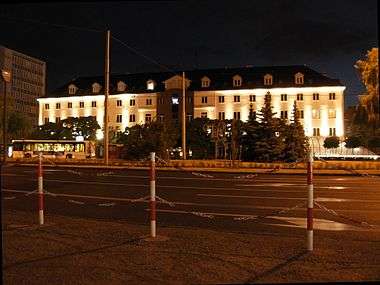
Main facade by night
-
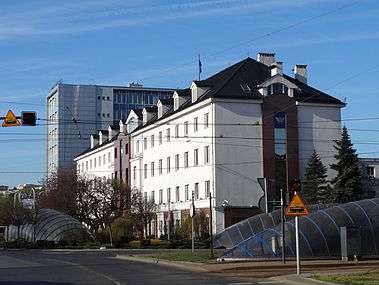
View from Bernardinska roundabout
See also
- Gdańska Street, Bydgoszcz
- Grodzka Street in Bydgoszcz
- Theatre square in Bydgoszcz
- Jagiellońska street in Bydgoszcz
- Stary Port Street in Bydgoszcz
Bibliography
- (Polish) Biskup Marian red.: Historia Bydgoszczy. Tom I do roku 1920. Warszawa-Poznań: Bydgoskie Towarzystwo Naukowe, 1991
- (Polish) Iłowski Henryk. Geniusz loci bernardynów bydgoskich. Kalendarz Bydgoski 2001
- (Polish) Klasztory bernardyńskie w Polsce w jej granicach historycznych. Praca zbiorowa pod red. Ks. Hieronima Eug. Wyczawskiego OFM. Wydawnictwo Bernardynów "Calvarianum". Kalwaria Zebrzydowska 1985, str. 35-40
- (Polish) Łbik Lech. Narodziny bydgoskiej parafii, średniowieczne świątynie, parafialny laikat, dekanat. Kronika Bydgoska – tom specjalny wydany z okazji wizyty papieża Jana Pawła II w Bydgoszczy. Bydgoszcz 1999
- (Polish) Zajączkowska Tamara: Tajemnice krypty klasztornej – czyli o interesujących odkryciach archeologicznych w kościele garnizonowym pod wezwaniem Najświętszej Marii Panny Królowej Pokoju w Bydgoszczy. Materiały do dziejów kultury i sztuki Bydgoszczy i regionu. Zeszyt 6. Bydgoszcz 2001
- (Polish) Parucka Krystyna. Zabytki Bydgoszczy – minikatalog. "Tifen" Krystyna Parucka. Bydgoszcz 2008.
- (Polish) Umiński Janusz: Bydgoszcz. Przewodnik: Bydgoszcz: Regionalny Oddział PTTK "Szlak Brdy", 1996.
- (Polish) Jerzy Derenda. Piękna stara Bydgoszcz – tom I z serii Bydgoszcz miasto na Kujawach. Praca zbiorowa. Towarzystwo Miłośników Miasta Bydgoszczy. Bydgoszcz 2006
- (Polish) Jacek Kajczuk. Mosty i wiadukty. Bydgoska Gospodarka Komunalna. Bydgoszcz 1996
- (Polish) Alfons Licznerski. Trudności budowy ul. Bernardyńskiej w latach 1855-1875. "Kalendarz Bydgoski" 1976
- (Polish) Stanisław Michalski (red.): Bydgoszcz wczoraj i dziś 1945-1980. Państwowe Wydawnictwo Naukowe. Warszawa-Poznań 1988
- (Polish) Monografia mostów województwa kujawsko-pomorskiego. Brda i Kanał Bydgoski. Tom II z serii: Mosty z biegiem rzek pod red. Krzysztofa Dudka. Bydgoszcz – Grudziądz 2012. Wydawca: Związek Mostowców Rzeczypospolitej Polskiej Oddział Pomorsko-Kujawski. ISBN 978-83-934160-2-8.
External links
References
- 1 2 Okoń Emanuel, Tandecki Janusz. Bydgoszcz – historia i rozwój przestrzenny. [w:] Czachorowski Antoni red.: Atlas historyczny miast polskich. Tom II Kujawy. Zeszyt I Bydgoszcz. Uniwersytet Mikołaja Kopernika. Toruń 1997
- 1 2 3 4 Licznerski Alfons. Trudności budowy ul. Bernardyńskiej w latach 1855-1875. [w.] Kalendarz Bydgoski 1976
- ↑ Od miasteczka do metropolii. Rozwój architektoniczny i urbanistyczny Bydgoszczy w latach 1850–1920, Iwona Jastrzębska-Puzowska: (2006). Mado, ed. Od miasteczka do metropolii. Rozwój architektoniczny i urbanistyczny Bydgoszczy w latach 1850–1920 (in Polish). ISBN 9788389886712.
- 1 2 3 4 Załącznik do uchwały Nr XXXIV/601/13 Sejmiku Województwa Kujawsko-Pomorskiego z dnia 20 maja 2013 r.
- ↑ Bydgoszcz Guide. Bydgoszcz: City of Bydgoszcz. July 2014. p. 18. ISBN 83-917786-7-3.
- 1 2 Zajączkowska, Tamara (2001). Tajemnice krypty klasztornej – czyli o interesujących odkryciach archeologicznych w kościele garnizonowym pod wezwaniem Najświętszej Marii Panny Królowej Pokoju w Bydgoszczy. Materiały do dziejów kultury i sztuki Bydgoszczy i regionu. Zeszyt 6. Bydgoszcz: PRACOWNIA DOKUMENTACJI I POPULARYZACJI ZABYTKÓW WOJEWÓDZKIEGO OŚRODKA KULTURY W BYDGOSZCZY. p. 13.
- ↑ Kantak, Kamil (1907). Kronika bernardynów bydgoskich. Poznań: Roczniki Towarzystwa Przyjaciół Nauk Poznańskiego.
- ↑ Kantak Kamil. Z przeszłości bernardynów bydgoskich. In. Przegląd Bydgoski Rocznik 1 R.1933 z.2
- ↑ Kościół katolicki w Bydgoszczy. Kalendarium. Praca zbiorowa. Autorzy: Borodij Eugeniusz, Chamot Marek, Kabaciński Ryszard, Kutta Janusz, Pastuszewski Stefan
- ↑ Historia Bydgoszczy. Tom I. Do roku 1920: red. Marian Biskup: Bydgoszcz: Państwowe Wydawnictwo Naukowe Warszawa-Poznań 1991. ISBN 83-01-06666-0, s. 498.
- ↑ Błażejewski Stanisław, Kutta Janusz, Romaniuk Marek: Bydgoski Słownik Biograficzny. Tom VI. Bydgoszcz 2000. ISBN 83-85327-58-4, s. 90.
- ↑ Historia Bydgoszczy. Tom I. Do roku 1920: red. Marian Biskup: Bydgoszcz: Państwowe Wydawnictwo Naukowe Warszawa-Poznań 1991. ISBN 83-01-06666-0, s. 590.
- ↑ Romaniuk Marek: Bydgoski "Pomnik Poległych". [w:] Materiały do dziejów kultury i sztuki Bydgoszczy i regionu. Zeszyt 7. Pracownia Dokumentacji i Popularyzacji Zabytków Wojewódzkiego Ośrodka Kultury w Bydgoszczy. Bydgoszcz 2002.
- 1 2 3 Historia Bydgoszczy. Tom II. Część pierwsza 1920-1939: red. Marian Biskup: Bydgoszcz: Bydgoskie Towarzystwo Naukowe 1999. ISBN 83-901329-0-7, s. 674-697.
- 1 2 Historia szkolnictwa wyższego w Bydgoszczy. red. Zygmunt Mackiewicz: Bydgoszcz: Bydgoskie Towarzystwo Naukowe 2004. ISBN 83-917322-7-4, s. 35-46.
- ↑ Parucka Krystyna. Zabytki Bydgoszczy – minikatalog. "Tifen" Krystyna Parucka. Bydgoszcz 2008. ISBN 978-83-927191-0-6.
- ↑ Artur Licznerski, Trudności budowy ul. Bernardyńskiej w latach 1855-1875, [w:] "Kalendarz Bydgoski 1976".
- ↑ Magdziarz Marek: Most Bernardyński w Bydgoszczy. [w:] Kronika Bydgoska tom XXXIX 2007. Towarzystwo Miłośników Miasta Bydgoszczy 2008. ISSN 0454-5451.
- ↑ Alfons Licznerski. Trudności budowy ul. Bernardyńskiej w latach 1855-1875. [w:] "Kalendarz Bydgoski" 1976.
- 1 2 Monografia mostów województwa kujawsko-pomorskiego. Brda i Kanał Bydgoski. Tom II z serii: Mosty z biegiem rzek pod red. Krzysztofa Dudka. Bydgoszcz – Grudziądz 2012. Wydawca: Związek Mostowców Rzeczypospolitej Polskiej Oddział Pomorsko-Kujawski. ISBN 978-83-934160-2-8.
- ↑ Kronika Bydgoska XV 1993. Bydgoszcz 1994
- ↑ Perlińska, Anna (1981). Bydgoszcz miasto wioślarzy. Kalendarz Bydgoski. Bydgoszcz: Towarzystwo Miłośnikćw Miasta Bydgoszczy.
- ↑ Bydgoszcz Guide. Bydgoszcz: City of Bydgoszcz. July 2014. p. 28. ISBN 83-917786-7-3.
- ↑ "Historia". zatoka.bydgoszcz. Restauracja ZATOKA. 2016. Retrieved 10 November 2016.
- ↑ Derenda Jerzy. Piękna stara Bydgoszcz – tom I z serii Bydgoszcz miasto na Kujawach. Praca zbiorowa. Towarzystwo Miłośników Miasta Bydgoszczy. Bydgoszcz 2006, str. 211
- ↑ Historia Bydgoszczy. Tom II. Część pierwsza 1920-1939: red. Marian Biskup: Bydgoszcz: Bydgoskie Towarzystwo Naukowe 1999. ISBN 83-901329-0-7, str. 651-700
- ↑ http://www.express.bydgoski.pl/look/article.tpl?IdLanguage=17&IdPublication=2&NrIssue=1469&NrSection=1&NrArticle=165960&IdTag=85 dostęp 24-03-2010
- ↑ Parucka Krystyna. Zabytki Bydgoszczy – minikatalog. "Tifen" Krystyna Parucka. Bydgoszcz 2008, str. 51
- ↑ "Archived copy". Archived from the original on 2012-02-25. Retrieved 2015-09-26. dostęp 24-11-2010
- ↑ Romeyko-Baciarelli Krystyna: Pocztowa historia. [w.] Kalendarz Bydgoski 2006
